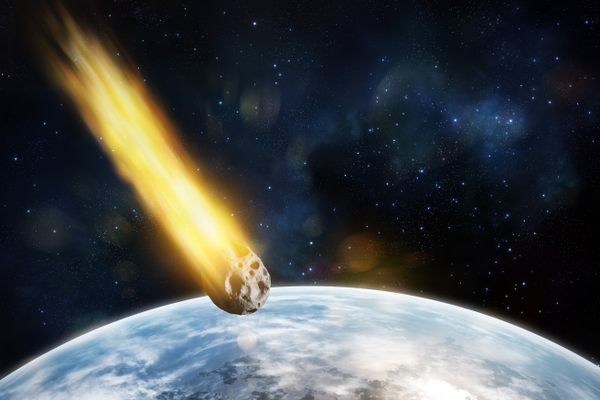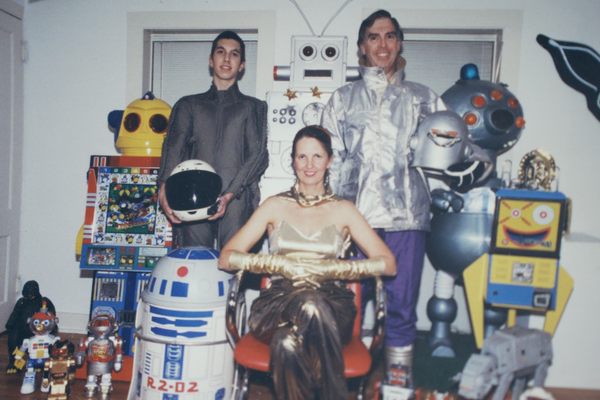
Probing the Secrets of the Universe From Deep in the Australian Outback
Extreme heat, ants, and stray cell phones are big concerns.
The largest radio telescope in the world—part of it, at least—is under construction in the Australian outback, nearly 200 miles from the already remote west coast city of Geraldton. But this is not the kind of telescope most people are familiar with. There are no lenses or domes, rather a patchwork of spindly antennas, arranged in groups of 16 and set on large tiles planted in the desert floor. Some parts of the installation look like a copse of skeletal metal trees. From above, the whole thing resembles a constellation of bridge parts, all connected with thick black cables. The facility is Australia’s part of an international, multi-billion dollar project to amass the input of hundreds of thousands of radio antennas, scattered across, in total, a million square meters. Hence the project’s name: the Square Kilometer Array (SKA).
There are few places on Earth better for hearing the subtle murmurings of universe than deep rural Australia, far away from the sources of interference that come with people, roads, and cities. (Another primary part of the SKA is in South Africa’s Karoo Desert, and other pieces are similar isolated in 11 other countries.) But this electromagnetic tranquility comes at a price: the challenges of a harsh desert environment and its denizens, both of which seem eager to impede the interstellar investigations.

The portion of the SKA in the outback is called the Murchison Radio-astronomy Observatory, or MRO, and is itself made up of a couple of distinct arrays of instruments. Amid brush and bungarras—large desert lizards—the MRO is, among other things, listening for evidence of a time, epically named the Epoch of Reionization, within the first billion years after the Big Bang. It was when galaxies and quasars first started to form, light reappeared after millions of years of darkness, and the cosmos as we recognize it today emerged. We can sense echoes of this time, 13 billion years ago, if we pay close enough attention.

“Obviously we know stars had to form at some stage, but we don’t know precisely when,” says Melanie Johnston-Hollitt, the director of the Murchison Widefield Array, part of the MRO.* “It’s somewhere between 400 and 700 million years after the Big Bang.”
Unlike an optical telescope that looks for electromagnetic waves in the visible spectrum, the observatory is sensitive to radio waves, which have a much larger wavelengths. “That’s a great thing about radio astronomy,” says Mia Walker, an engineer at the array. “You don’t have to wait until the sky gets dark before you can do some work.”

Much like light from the sun makes it impossible to see the stars during the day, a radio telescope can’t sense anything unless it is isolated from other sources of radio waves—which means it needs to be far away from just about everywhere. And even once researchers have found a place free of AM and FM signals, wireless communications, and more, it’s always a challenge to keep it that way.
“The MRO is special because it is preserved as a radio quiet zone,” says Johnston-Hollitt. “The observatory itself is 127 square kilometers [50 square miles] and is protected under Australian law from radio transmissions.”
And that’s why most humans are prohibited from going anywhere near it. We’re loud, and the electronics in our pockets are constantly emitting radio waves—the pings from our cell phones as they search for a signal. Trying to sense the residue of the early universe while carrying a cell phone is like to trying to hear a mouse’s footsteps next to a rocket launch. For that reason, Johnston-Hollitt says, the public (and only 300 members of it) can visit the site, on one weekend every two years.
The important thing—keeping humans away—has proven to be the easy part. The site’s scientists, engineers, operations staff, and contractors also have to deal with a bevy of beasts. Some are small, some are big, and many seem to take an intimate, vested interest in sabotaging the cosmos-probing instruments.

“Ants love electricity and can short out the electronics in our antennas, termite mounds can actually grow up around our antennas—they can have those ones—kangaroos have kicked over our hardware before, and wild dogs can get curious about our equipment too,” says Walker. “I remember seeing puppy paw prints on a solar panel.”
The ants pose a particular problem. Their size allows for more electrical havoc than the other animals, even the drop-kicking kangaroos, can muster. “They crawl onto the little circuit boards inside our antennas and their bodies are small and conductive enough to bridge the gaps between parts of the circuit, which can make things short out and fail,” she says. “Reeeally annoying when you have to walk two kilometers into the desert to change out electronics because of ants!”
The giant lizards, which can grow well over four feet long, are less of a problem. “The bungarras are harmless, and they’re all named ‘Steve,’” says Walker. “The running joke is that they are all the same Steve, the same bungarra. One time, ‘Steve’ was obviously pregnant, so he temporarily became ‘Stevette.’”

Even accounting for humans and animals, the biggest obstacle to the ongoing performance of the radio telescope is the desert itself.
“Fauna are sometimes a problem, as with any remote site, but in terms of things we have to protect the telescope from, the weather is probably the most important,” says Johnston-Hollitt, citing lightning strikes, water runoff, extreme heat, and ultraviolet radiation, which can disintegrate components all by itself.
Deep time will tell whether the frequency sleuthing at the MRO pays off and provides greater detail on the moment—technically lasting hundreds of millions of years—when the universe began to resemble the giant expanse of wonder and nothingness we know today. But amid the disturbances—human, animal, climatological—the scientists out there persevere, their ears and instruments open to the stirrings of the cosmos.
* Correction: The original version of this story identified Johnston-Hollitt as director of the MRO. She is director of the Murchison Widefield Array within the observatory.
























Follow us on Twitter to get the latest on the world's hidden wonders.
Like us on Facebook to get the latest on the world's hidden wonders.
Follow us on Twitter Like us on Facebook